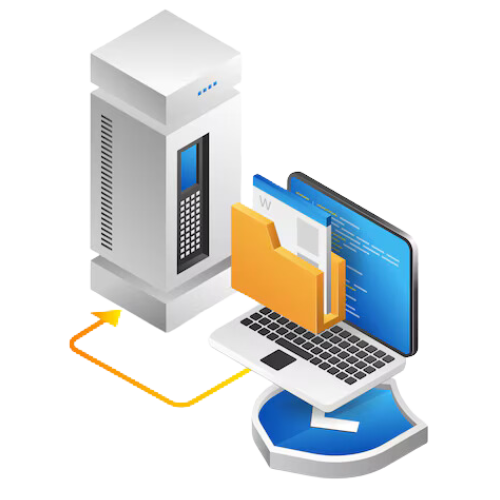Qnap NAS Data Recovery Tool
Use QNAP Nas Recovery Tool to Recover Data
QNAP NAS (Network-Attached Storage) devices let homes and businesses store all of their files in one place. However, these devices can still lose info for several reasons. In these cases, the QNAP NAS Recovery Tool can be very helpful as it can help you get back data that you have lost or can’t get to. This guide goes into great detail about the QNAP NAS Recovery Tools features, functions, and best practices. It will help you recover data on your NAS successfully.
What the QNAP NAS Recovery Tool Can Do
This is the QNAP NAS Recovery Tool, an easy-to-use piece of software that can help you get back lost data from QNAP NAS systems. Here are a few of its most important parts:
Supported Case Studies: The Tool helps with many types of data loss, such as deletion by mistake, formatting, file system corruption, and sudden system crashes.

Modes of Recovery: Light Scan and Deep Scan are the two recovery types it has. Light Scan focuses on speed and can find files that were just removed. Deep Scan is a more thorough choice that might be able to recover data from more complicated situations, but it takes longer.
Functions of Preview: Before you restore files, the Tool lets you look at them to make sure you understand what they contain and why they are important. This helps you decide what data to recover first and avoid getting back data that you don’t need.
How to Search and Filter: It’s easier to find the data you need in big datasets when you can search for specific files by name or type with the Tool.
Being flexible: Depending on your preferences and concerns about data security, you can choose to restore files to where they were on the NAS or to a different storage device.
What to Do and What Not to Do for Successful NAS Data Recovery
The QNAP NAS Recovery Tool is a useful tool, but what you do with it can affect how well you recover your files. Here are some very important things to remember:
Follow these steps to learn how to use the QNAP NAS Recovery Tool:
Here’s how to use the QNAP NAS Recovery Tool to get back lost info, step by step
From the official QNAP website, you can get the QNAP NAS Recovery Tool that works with your type of NAS. Put it on a computer that is linked to your NAS’s network.
Start the QNAP NAS Recovery Wizard program that you got. From the list of network devices that have been found, choose your NAS.
Light Scan and Deep Scan are the two recovery modes that the Tool usually gives you. Light Scan looks for recently deleted files first and is faster than Deep Scan. Deep Scan looks for data from more complicated situations and is more thorough. Pick the mode that works best for your data loss.
Click on the storage volume on your NAS where the data loss happened. Most NAS devices have more than one storage space, so it’s important to find the right one.
Click the “Start” button to start the scan. Any mode you choose and the amount of space on your NAS will affect how long the check takes.
When the check is done, the Wizard shows a list of files that might be recoverable. You can look at these files to ensure they are what you want them to be before you start the restore process.
To choose the files you want to recover, you can either click on each one directly or use the “Select All” button. Click the “Recover” icon to initiate the recovery procedure.
Pick out the place where you want to get the files back. You can choose where they were originally saved on the NAS or another computer-connected drive.

An Introduction to Data Recovery from Your NAS
Advantages of Employing the QNAP NAS Recovery Tool in Diverse Data Loss Circumstances
In numerous data loss scenarios, the QNAP NAS Recovery Tool provides a variety of advantages, rendering it an invaluable instrument for NAS users. The following is a division of how it can be of assistance in particular circumstances:
Constraints regarding the QNAP NAS Recovery Tool
Although the QNAP NAS Recovery Tool is an advantageous application, its limitations must be recognized. The following situations may render it unsuitable as a resolution:
Beyond the Tool: Supplementary Methods for Data Recovery
Utilizing the QNAP NAS Recovery Tool to safeguard your NAS against data loss is an invaluable first step. Nevertheless, a comprehensive approach to data recovery software extends beyond the mere utilization of software. Several supplementary strategies warrant contemplation:
Frequently Asked Questions
The purpose of the QNAP NAS Recovery Tool is to aid in the restoration of data that has been misplaced or is unreachable from QNAP NAS (Network-Attached Storage) devices. The software provides an intuitive interface that assists users in regaining data in a variety of circumstances, including unintended deletion, formatting mistakes, and unanticipated system shutdowns.
Facilitates data recovery in a variety of data loss scenarios.
It provides two scan modes: Deep Scan, which is more exhaustive for complex scenarios, and Light Scan, which is quicker for recently expunged files.
Enables file previewing before recovery to verify the content and pertinence.
Filter and search capabilities for locating specific files.
Permits recovery destination selection (original NAS location or an alternative storage device).
- Erroneous removal of directories or files.
- Wrong formatting of storage volumes on a NAS.
- A corruption in the file system renders files inaccessible.
- Unanticipated system shutdowns that result in the loss of data.
- Loss of partial data in which an inaccessible portion of a file remains.
Restoring Deleted Data: Immediately cease using the NAS in order to mitigate the potential for overwriting the lost information with new data.
Utilizing Third-Party Disk Utility Tools: It is advisable to refrain from employing incompatible tools that have the potential to cause harm to the QNAP file system.
Concerned and speculative: Prior to attempting recovery methods, consult the QNAP NAS user manual or technical support for direction.
Accelerate Response: Commencing the recovery process subsequent to data loss will result in a greater likelihood of success.
Install the Tool: The Wizard version that corresponds to your NAS model can be downloaded from the official QNAP website.
Maintain Backups: For future security purposes, back up data frequently to an external drive or the cloud.
It is imperative to diligently adhere to the on-screen guidance presented by the Wizard throughout the recovery procedure.
- Download and install the Wizard that corresponds to the variant of your NAS.
- Navigate to the network selection and select your NAS by launching the Tool.
- Select an appropriate recovery mode (Light Scan or Deep Scan) according to the nature of the data loss.
- Determine which storage volume experienced the data loss.
- Commence the scanning procedure.
- Verify the content of recovered files by examining their previews.
- Specify and retrieve files of interest, designating a location for the recovered data.
Data recovery from formatted volumes is a distinct possibility, particularly when employing rapid formatting techniques that do not substantially overwrite pre-existing information. The Deep Scan mode is more appropriate in such circumstances.
The QNAP NAS Recovery Tool may, under certain circumstances, attempt to restore access to corrupted file systems, thereby potentially restoring data accessibility. Severe corruption, on the other hand, may necessitate superior data recovery methods.
The Tool may prove beneficial in such circumstances. Utilizing the Light Scan mode to recover recently modified files that were not saved before the shutdown is a decent starting point.
It is possible that the Tool could extract recoverable segments of the data, notwithstanding the file’s complete un-salvageability. The preview feature aids in evaluating the recovery process and ascertaining whether the recovered segment is functional.
Overwritten Data: The Tool is unable to recover overwritten data.
Storage drives that have sustained severe hardware damage necessitate the utilization of professional data recovery services.
Recovery of Encrypted Data: The Tool is incapable of decrypting data. At least a genuine encryption key is required.
Complex RAID Failure: If multiple drives fail in a RAID configuration, it may not be feasible to perform a comprehensive data recovery.
Hardware repair and professional data recovery services with expertise in complex scenarios should be considered. They may utilize sophisticated methodologies that surpass the Tool’s capabilities.
Critical is the implementation of a robust fallback strategy. Maintain a copy of your NAS data on a cloud storage service or a distinct external drive in the event of a failure.
Undoubtedly, the QNAP NAS Recovery Tool represents an exceptional alternative when it comes to retrieving recently erased data. Regarding your circumstance, Light Scan is an excellent starting point. It facilitates the recovery of recently deleted files and folders at a quicker rate. Upon completion of the scan, the expunged folder and its contents should be visible in the Tool’s interface. Before beginning the recovery process, verify that the documents you are referring to are in the preview.
The potential utility of the QNAP NAS Recovery Tool extends to certain instances of file system corruption. It possesses the capability to attempt restorations, which may grant you access to your data once more. Nevertheless, the degree of success is contingent upon the extent of the corruption. The Tool may be unable to completely restore the file system if the corruption is severe. After exhausting all other options, it is advisable to investigate professional data recovery services that specialize in file system restoration and take into account the limitations.
Although the QNAP NAS Recovery Tool is a valuable instrument, it may not be the exclusive remedy for recovering data in the event of a RAID failure, particularly when a single drive fails. Redundancy is the purpose of RAID 5, which has a failure tolerance of one drive. Nevertheless, the Wizard’s ability to aid in the RAID rebuild procedure may be constrained.
Reconstruct the RAID: Instructions regarding the utilization of the QNAP NAS’s built-in functionalities to initiate a RAID rebuild should be sought from the user manual or technical support. You ought to regain access to your data following a successful rebuild utilizing the remaining functional drives.
Tool for Recovery of Data: The Tool retains its utility even after a successful rebuild, enabling the recovery of data that may have been marginally corrupted or inconsistent during the failure. Potentially assisting in the detection and recovery of such data fragments is the Deep Scan mode.
The QNAP NAS Recovery Tool is incapable of decrypting data. If the data was encrypted before the system collapsed, accessing the recovered information will require a valid encryption key. Nonetheless, the Tool may still be capable of the following:
Recover Underlying Data Structure: It is possible that the Tool could assist in the recovery of the underlying data structure that contained the encrypted files.
Recover with Encryption Key: Possessing a backup of your encryption key may enable you to decrypt the data structure that has been recovered using the Tool, allowing you to access your information.
Undoubtedly so! The following precautionary measures are essential for reducing the likelihood of data loss:
Consistent Backups: Establish a comprehensive backup strategy. It is recommended to regularly back up the data on your NAS to an external drive or cloud storage service. This guarantees that you possess a duplicate of your data in the event that your NAS malfunctions.
It is advisable to implement version control systems when dealing with mission-critical data. These systems monitor file modifications over time, enabling users to revert to earlier versions when required. This feature is highly beneficial in situations where one inadvertently deletes or modifies a file and subsequently requires an earlier version.
Software Updates: Ensure that the operating system and applications of your QNAP NAS are always running the most recent security updates and bug fixes. This mitigates potential vulnerabilities that could result in the loss of data.
There are circumstances in which the QNAP NAS Recovery Tool may be adequate. In certain circumstances, however, it may not be the most effective course of action. The following alternatives merit contemplation:
Professional Data Recovery Services: The QNAP NAS Recovery Tool may be incapable of handling significant data loss. Sophisticated data recovery services possess the necessary knowledge and capabilities to handle intricate circumstances, such as severe hardware damage or complex RAID failure involving multiple failed drives.
Data Extraction from Failed Drives: Data recovery software will be rendered ineffective in cases where data loss occurs due to physical damage sustained by the storage drives contained within the NAS. Professional data recovery services that specialize in the repair of physical media and data extraction may be required in such circumstances.

Need Any Kind Of IT Solution?

